Certainly, there’s really no easy way when it comes to understanding your customer’s experience. Many turn to customer journey maps. There are positives and negatives that come with customer journey maps, and like any other marketing research and documentation, it comes down to two things:
- Identifying the goal and purpose behind it,
- Knowing how actually to apply and use it.
If you go with customer journey maps, we highly recommend you keep the two criteria in mind.
In this post, we’ll be detailing the steps to help you craft a complete and comprehensive customer journey map for your business and discuss how to evaluate and use it effectively.
What Is A Customer Journey?
A customer journey refers to the process that a customer goes through when interacting with a business or brand, from the initial contact to the final purchase and beyond. It encompasses all the touchpoints and interactions a customer has with a company, both online and offline, throughout their entire relationship.
Understanding the customer journey is essential for businesses as it helps them identify opportunities for improving customer experience, optimizing marketing efforts, and building long-term relationships with customers. By mapping out the customer journey, businesses can tailor their strategies and communications to meet the needs of customers at each stage, ultimately enhancing customer satisfaction and loyalty.
What Is A Customer Journey Map?
A customer journey map is a visual representation of a customer’s experience with a company or product, from initial awareness all the way through to post-purchase follow-up. It’s a marketing tool used to understand the customer’s experience at each stage of the buying process and identify opportunities to improve that experience.
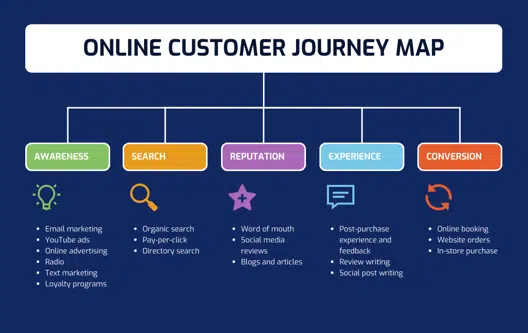
These maps are a compact visualization of an end-to-end customer experience, and they can take many forms (infographics, illustrations, diagrams – all that good stuff). A customer journey map illustrates all the places and touchpoints customers come into contact with your brand, online or off… and they help you look at your brand, product, and processes through the customer’s lens so that you can visualize the literal customer journey through the funnel.
In this post, we’ll be detailing the steps to help you craft a complete and comprehensive customer journey map for your business and discuss how to evaluate and use it effectively.
How To Create A Customer Journey Map
I had a chat with Khalid, and he had this to say;
“The way we build the customer journey maps is through jobs to be done analysis.
When we start working with a company, we tell them to give us people, recent customers who just bought the items, and they’re still fresh in their minds.
Most interviews are forward-looking but don’t help build the customer journey map. Rather, we go backward and ask them questions like what was going on in their life that day they decided to purchase the item, etc.
We repeat this process across 5 to 10 customers, and then we go further to run website polls and send email surveys to validate the insights we got from JTBD.
All this yields so much insight that helps us see the different steps taken by customers.”
https://youtu.be/_kUexbOmbf0
Matthew Fairweather, director of Matthew Fairweather Ltd, says:
Customer journey mapping is really a mixture of art and insight… But that’s just a visual aid. The real work in customer journey mapping is using all of the customer information and data available to you from across the business and delivering a process and structure to their experience.
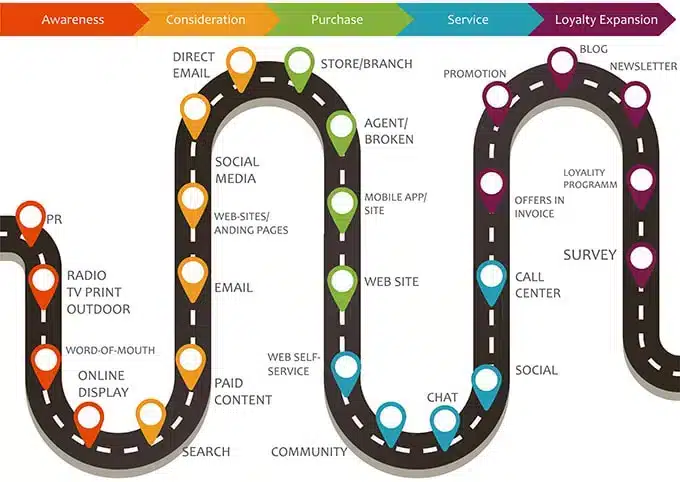
Here’s what you need to create an effective customer journey map:
1. Nail down your buyer persona
The first step in creating a customer journey map is understanding who your customers are.
Shay Namdarian of Collective Campus explains:
To best understand the customer, organizations need to develop personas. Really get into their shoes so you understand how they behave (including likes and dislikes) and why they do what they do. Although everyone is unique, these customer profiles provide guidance and input for the journey mapping.
If you haven’t already done so, get started on developing your buyer personas.
While doing this, keep in mind that it isn’t sufficient to have just one buyer persona. People at different buying stages will behave and interact with your business differently. So it’s worth distinguishing between someone who has been doing market research for a few months and is ready to make their purchase. And someone who has only recently begun thinking about solving their particular need (by trying your product/service).
2. Understand your buyer’s goals
Once you have your buyer personas built, the next step is to dig deep and understand what each of them hopes to achieve as they go through the customer journey.
Think about what your customers’ ultimate goals are in each phase (and remember that these may change as the process unfolds).
Some examples might be:
- Researching the different options that are available.
- Ensuring that s/he is paying a fair price.
- Seeking reassurance that s/he has all the necessary information about the product.
A great way to go about doing this is first to identify the paths that your visitor may take on your site. If your visitor is a member or a pre-existing customer, the first thing that they might do is to log in. Other activities include browsing, searching for products, and comparing products. Once you’ve nailed down a full list of these activities, you’ll be able to identify all your touchpoints and the goals associated with each touchpoint.
The next step is to determine the goals for each customer phase clearly on your map (as demonstrated in this sample map from Heart of the Customer).

By doing this, you’ll be able to examine how well you are meeting those goals and answering customers’ questions.
Different ways to understand customers’ goals
- Survey/interview different customer groups
- Get user testing feedback
- Study customer support emails/transcripts
- Identify customer questions in each phase
- Use customer analytics tools like FigPii to gather information
3. Map out buyer touchpoints
A “touchpoint” refers to any time a customer comes into contact with your brand – before, during, or after they purchase something from you. This also includes moments that happen offline/online, through marketing, in person, or over the phone.
You’ll want to take all potential touchpoints that occur between your customers and your organization into account. That way, you won’t miss out on any opportunities to listen to your customers and make improvements that will keep them happy.
So, how, then, do you identify customer touchpoints?
Because there are so many different ways for customers to experience your brand, the idea of figuring out all potential touchpoints may seem daunting at first.
However, you can make this task easier by putting yourself in your customer’s shoes and walking through their journey step-by-step.
Ask yourself the following:
“Where do I go (and how do I get there) when…”
- …I have a [problem that your product/company solves].
- …I discover the product or business that solves my problem.
- …I made my purchase decision.
- …I encountered the business again after the purchase.
This should reveal all touchpoints pretty clearly.
Another way of accomplishing this task would be to ask customers directly about their experience with your brand – or put the above questions into a survey.
Additional tip: Use Google Analytics
If you have Google Analytics 4 set up for your website, there are two reports which you may find useful:
1. Behavior flow report
This report displays how a customer moves through your site, one interaction at a time.
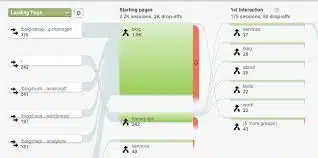
It’s great for helping you understand how customers behave and what paths they take while navigating your website. It also reveals specific sources, mediums, campaigns, or geographical locations they come from.
Additionally, it can help you identify any pain points on your site where users may be struggling.
2. Goal flow report
The goal flow report displays the path visitors follow to complete a goal conversion.

It helps reveal how traffic navigates through your funnel and whether there are any points with high drop-off rates or unexpected traffic loops that need to be addressed.
4. Identify customer pain points
At this point, it’s time to bring together all your data (both quantitative and qualitative) and look at the big picture to identify potential roadblocks or pain points in the customer journey. You may also want to note down areas where you’re currently doing things right and figure out ways to improve.
To do this, ask yourself questions and interview customers and customer-facing staff.
Some potential questions might include:
- Are my customers achieving their goals on my website?
- Where are the main areas of friction and frustration?
- Where are people abandoning purchases (and why)?
Once you know where the roadblocks and pain points are, mark them down on your customer journey map.
For example, take this chart from UserTesting, which depicts positive and negative customer experiences by color code.

5. Prioritize and fix roadblocks
If you look at it from a micro perspective, here are some questions you can ask yourself: What needs to be corrected or built? Is there a need to break everything down and start from scratch? Or are a few simple changes necessary for a big impact?
For instance, if customers frequently complain about how complicated your sign-up process is, it’s probably time to revamp it and make things easier.
After identifying these roadblocks, take a step back and look at the big picture from a macro perspective. Recognize that the end goal is not to optimize each step or touchpoint just for the sake of optimizing it but so that you can push your customers down the funnel and bring them one step closer to converting.
At the end of the day, you want to be getting more conversions. So everything you tweak in each customer touchpoint should all be contributing to that one goal.
A Case Against Customer Journey Map
While fixing your roadblocks, here’s something to consider: most customer journey maps are company-centric. They look at touchpoints based on the company’s perception of where the customers should be. Instead of where customers are actually at.
Bearing this in mind, it makes sense to try and shift from this older, more traditional style of mapping to looking at a customer journey map as a model in which you can identify points to educate your customer. The key here is to build a content marketing strategy and an inbound marketing strategy that is compelling. So that it will draw your customers to engage with you and learn more about your products and your brand.
6. Update and Improve
Your customer journey map shouldn’t be left to gather dust on the shelf once it’s completed. Because your customers are constantly changing and evolving, your customer journey map should also be doing the same. Consider it a living document that will continue to grow and develop.
If possible, test, update, and improve your customer journey map every six months or so. In addition, customer journey maps should also be tweaked accordingly whenever you introduce significant changes to your product/service.
Stages Of A Customer Journey Map
The customer journey can be divided into several stages, which may vary slightly depending on the source but generally include the following:
1. Awareness:
This is the stage where a customer first becomes aware of a product, service, or brand. This awareness can happen through various channels such as advertising, social media, word-of-mouth, or online search.
2. Consideration:
After becoming aware of the product or service, the customer starts to research and consider their options. They might compare different brands, read reviews, and gather information to make an informed decision.
3. Decision:
In this stage, the customer decides to make a purchase. They have evaluated their options and are ready to buy. This could happen online or in a physical store.
4. Purchase:
The customer makes the actual purchase, completes the transaction, and becomes a paying customer.
5. Post-Purchase Experience:
The relationship between the customer and the business doesn’t end after the purchase. Businesses often engage in post-purchase activities such as follow-up emails, customer support, loyalty programs, and soliciting feedback. This stage is crucial for customer retention and building brand loyalty.
6. Advocacy:
If the customer is satisfied with their purchase and overall experience, they might become an advocate for the brand. They could recommend the product or service to others, write positive reviews, or engage with the brand on social media, thus influencing other potential customers.
Components Of A Customer Journey Map
There are different types of customer journey maps, but to create good customer journey maps, you have to include the following five components:
1. Touchpoints:
Touchpoints are the interactions between the customer and the business at various stages of the journey. These can be online, such as website visits or social media interactions, or offline, such as in-store experiences or customer service calls. Identifying touchpoints helps businesses understand where and how customers engage with the brand.
2. Customer Actions:
Customer actions represent the specific activities or behaviors customers undertake during their journey. This could include researching products, reading reviews, making a purchase, or seeking customer support. Understanding these actions provides insights into customer behavior and intentions.
3. Emotions and Motivations:
Emotions and motivations delve into the customer’s feelings and reasons behind their actions. Customers might feel excited, frustrated, satisfied, or confused at different stages of their journey. Identifying these emotions helps businesses empathize with customers and design experiences that resonate emotionally.
4. Pain Points:
Pain points are obstacles, challenges, or frustrations that customers encounter during their interactions. These could be issues with website navigation, unclear product information, or unsatisfactory customer service. Pinpointing pain points highlights areas that need improvement and can guide businesses in creating solutions.
5. Opportunities:
Opportunities are areas where businesses can exceed customer expectations and create memorable experiences. These could be personalized recommendations, proactive customer support, or loyalty rewards. Identifying opportunities helps businesses enhance customer satisfaction and build brand loyalty.
Types of Customer Journey Maps?
Since the customer journey is not linear, it also makes sense to have different types of customer journey process(s). There are different types of customer journey maps, and they all can help you improve the customer experience – but you have to choose/create a customer journey that aligns with your specific purpose. That said, now let’s take a look at each one of them:
1. Current State Journey Mapping
If you want to understand better what your customer experiences while interacting with your product or service right now, consider using current state mapping. This type of journey mapping is about visualizing your customers’ thoughts, actions, and emotions as they interact with your brand’s touchpoints.
Suppose you have a huge amount of visitors using the Chrome browser to access your site, but most of them leave your site without converting. You also notice from the journey map that the same type of customers use Safari or Mozilla Firefox browser to make a purchase.
Equipped with this kind of data, you can tell that your customers using Chrome to access your access are probably facing some issues. Current state mapping allows you to compare customer experience between these different browsers, therefore giving you room to uncover conversion roadblocks on underperforming browsers.
2. Future State Journey Mapping
As the name suggests, future state mapping helps you visualize what thoughts, actions, and emotions your customers will probably experience when interacting with your company in the future. In other words, they help you visualize the ideal journey you’d like your customers to embark on as they interact with your brand.
The future state is an effective customer journey map which is ideal for teams who want to close the gap between the current customer’s experience and where it should be. One important thing to note here is that there’s no future state customer journey design without mapping the current state first. You need to conduct research first, understand the current state, and then work on your future state.
You can also design a future state map if you have a new product or service and you want to illustrate your vision to your team and set clear strategic goals. Here are some more reasons why you should consider designing future-state journey maps:
- Keeps the focus on the customer
- Drive strategy
- Align teams
- Control power dynamics
- Uncover future pain points you’ll need to optimize
- Extract and articulate a vision
Unlike current state maps, future state maps are driven by business strategy.
3. Day in the Life Mapping
Sometimes, it’s necessary to know your customers’ real-life pain points. And, sometimes, when you look beyond how a customer interacts with your brand, you get to discover more about your customer behavior. This may entail asking for customer feedback or mapping day-in-the-life journey maps.
Day in the life mapping visually represents the customer’s journey in their real-life day-to-day activities. This type of journey map differs from the aforementioned ones in that it’s more about insight discovery than optimization. So it helps you discover your ideal customer touchpoints outside of your product, service, or brand.
4. Empathy Maps
Empathy maps are a tool that helps organizations gain a better understanding of their customers by mapping out their thoughts and feelings during the various stages of their journey. The purpose of empathy maps is to encourage organizations to think about their customers’ needs and desires in a more holistic way by taking into account their emotional responses, pain points, and motivations.
Empathy maps typically consist of four quadrants that represent the four key areas of a customer’s experience: their thoughts and feelings, their actions and behaviors, their pain points and challenges, and their motivations and goals. The quadrants are typically labeled “Say,” “Do,” “Think/Feel,” and “Pain/Gain,” respectively.
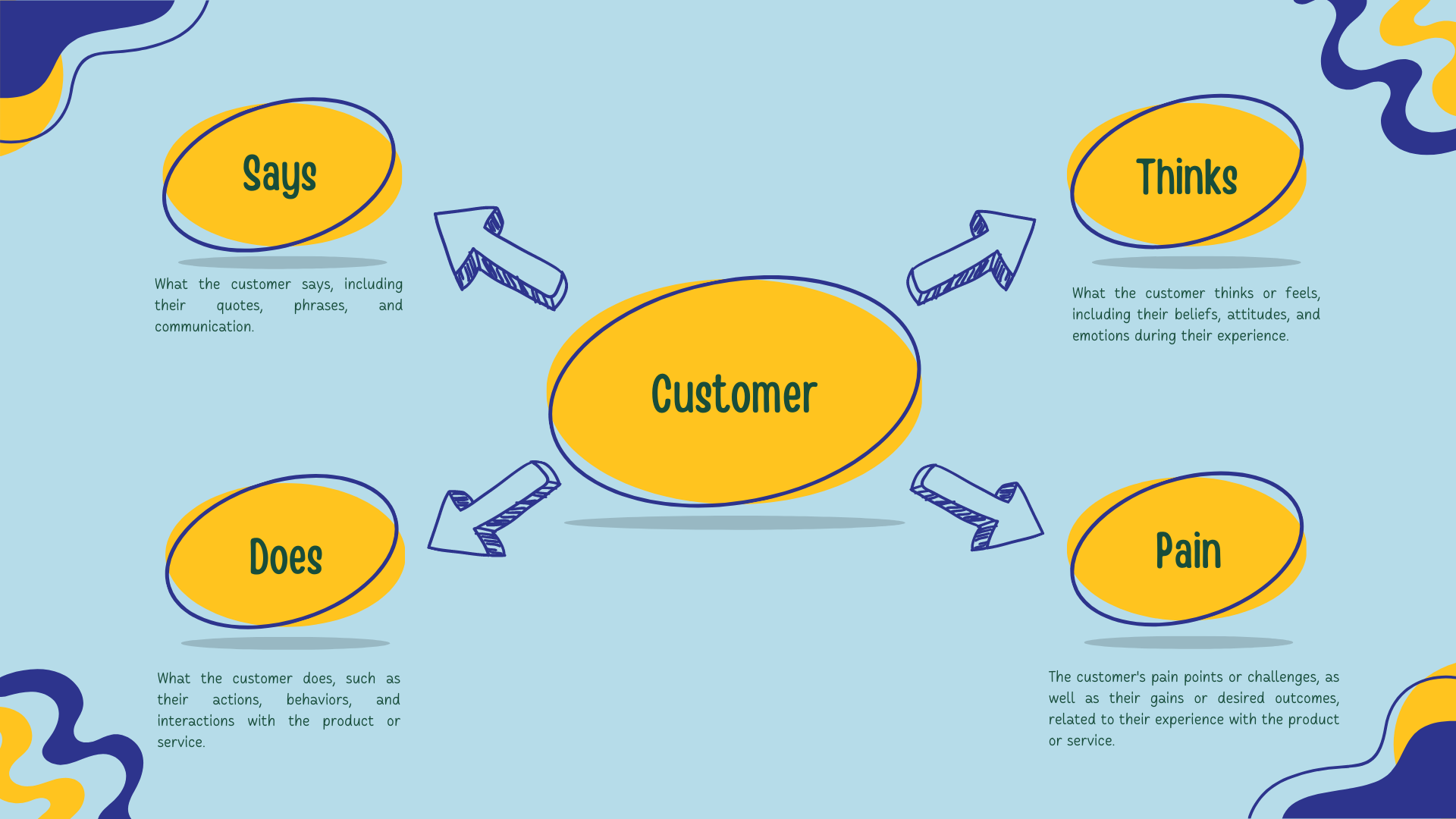
By using empathy maps, organizations can better understand their customers and develop more targeted strategies for engaging with them at each customer journey stage. Empathy maps can also be used to identify areas of improvement in a company’s products or services and develop more effective messaging and marketing campaigns.
Customer Journey Map Examples
To help provide you with a starting point, here are some awesome customer journey mapping examples you can use as customer journey map templates to create your own:
1. Dapper Apps
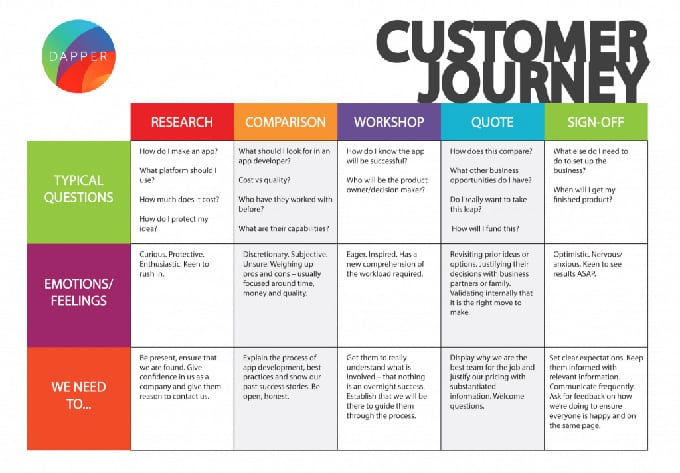
Dapper Apps’ customer journey map has five main phases:
- Research
- Comparison
- Workshop
- Quote
- Sign-Off
These help you systematically organize all your information about how your customer is interacting with your brand and gain insights from the knowledge.
2. IdeaRocket

dea Rocket’s customer journey map, on the other hand, follows a mostly circular path with 6 main phases:
- Interest
- Consideration
- Evaluation
- Pre-Production
- Production
- Video Usage.
While simple, it clearly outlines their process during each step of the customer journey. Based on insights from their SEM lead generation, the company focuses its CTAs for each phase according to what is appropriate for the visitor’s circumstances.
Customer Journey Map Templates
There isn’t an official template that you should be using… simply because no two customer journeys are the same!
Depending on the business, product, or service that is being mapped, best practices and design may vary. This means you have a great deal of freedom to explore and be creative – so construct your basic customer journey map using the following steps, and then go ahead and embellish it all you want.
However, if you need inspiration for your customer journey mapping process, here are some templates you can use:
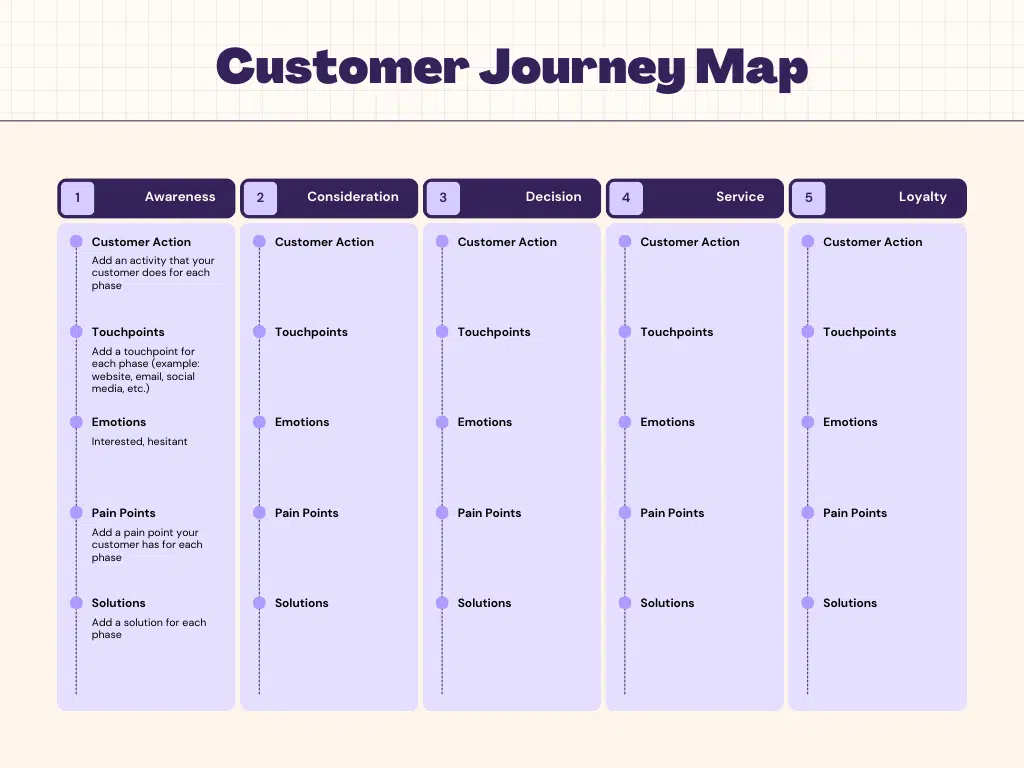
The internet is not short of examples of customer journey map templates. You can look for more templates on websites like Canva and Lucidchart.
Customer Journey Mapping Benefits
As David Weaver (co-founder of Vintage Cash Cow) explains:
“A successful customer journey map will give you real insight into what your customers want and any parts of your product, brand or process that aren’t delivering.”
Customer journey maps are important for brands and come with many benefits. Here are some of the purposes of using customer journey mapping tools:
1. Identifying customer pain points:
At each step of the customer journey, you can get a deeper understanding of customer needs, actions, and what kind of questions they have. Knowing what kind of questions your customers have can help you know what you should really address on your websites. At the end of the day, you end up improving customer experiences.
2. Improves customer retention:
A well-crafted customer journey map considers post-purchase experiences. That knowledge helps you know why customers leave. And when you know this, you can enhance your strengths and improve your weaknesses.
3. Improves your marketing efforts:
When you understand how customers make decisions and which platforms they tend to use the most, you can create campaigns that are tailored to address their needs on those platforms.
4. You understand your customers better:
When you know all the touchpoints of your customers, you get an understanding of how your buyer personas navigate through your conversion funnel. This helps you personalize your marketing strategies in a way that leads to a positive customer experience.
Customer journey maps give businesses a way of getting into their customers’ heads, helping them gain valuable insight and understanding regarding common customer pain points. They also aid in building empathy for customers, helping brands understand what buyers want and how they feel.
5. Creates a new customer target base.
There’s a mental picture you have of who you think your customer is. In reality, most times, that’s not your ideal customer.
If you fail to have a customer journey map, you probably don’t completely know the demographics and psychographics of your customers.
This is bad for your business, and that’s because you keep throwing money down the drain targeting broad customer segments and interests. This leads to a spike in your CAC.
Researching your typical customers’ needs and pain points and mapping out their journey will give you a good picture of the people trying to achieve a goal with your company. Thus, you can hone your marketing to that specific audience.
6. Improves customer retention rate.
A customer journey map gives you a full view of your customer’s buying process. This view helps you see areas of difficulty that your customer might encounter, and you can improve their experience there.
Being proactive in improving your customer experience and decreasing their friction points will encourage more customers to stay with your company.
A customer journey map shows you individuals who are on the path to churn. If you log the common behaviors and actions of these customers, you can start to spot them before they leave your business. While you might not save them all, it’s worth the try since increasing customer retention rates by just 5% can increase profits by 25%-95%.
Final Thoughts
We’re entering an age where businesses are all about the customer experience.
By shifting the focus to the customer’s perspective, brands can better understand consumer wants and needs. This allows them to create a more effective and satisfying customer experience.
A customer journey map is a proven framework for helping drive greater customer insights and improving internal efficiencies. While they are more significant than a “silver bullet,” they are still exceptionally effective tools for helping brands identify engagement and enhancement opportunities, increase conversions, and bring in eye-popping ROI.
Are you using customer journey maps for your business? Feel free to share any tips we may have missed in the comments.
We’d love to hear from you!
Customer Journey Maps FAQs
1. When should you create a customer journey map?
Customer journey maps should be created when you want to understand your customers’ experiences and interactions with your business. It’s beneficial during the planning phase of marketing campaigns, when launching a new product or service, or when you’re looking to improve your existing customer experience.
2. How do you create an effective journey map?
To create an effective journey map, start by researching your customers, identifying touchpoints, understanding emotions and motivations, pinpointing pain points, and recognizing opportunities. Engage with real customers, use surveys and analytics, and collaborate with various teams within your organization. Regularly update the map based on evolving customer needs and feedback.
3. Why are customer journey maps important for digital marketers?
Customer journey maps are crucial for digital marketers because they provide insights into customer behavior online. By understanding the customer’s digital interactions, marketers can optimize website design, personalize content, target specific touchpoints, and enhance online experiences. This knowledge helps in creating targeted, effective digital marketing campaigns.
4. What makes a successful customer journey?
A successful customer journey involves seamless interactions, personalized experiences, and meeting customer needs and expectations at every stage. It is characterized by clear communication, easy navigation, quick problem resolution, and emotional connection. Successful customer journeys result in satisfied, loyal customers who are likely to engage with the brand repeatedly and recommend it to others.
5. What’s the difference between customer journey and buyer journey?
The key difference between the customer journey and the buyer journey lies in their focus and scope. The customer journey encompasses the entire relationship between a customer and a brand, including pre-purchase stages, the actual purchase, and post-purchase interactions. It emphasizes long-term customer satisfaction and loyalty. On the other hand, the buyer journey specifically concentrates on the stages leading up to a purchase decision, from recognizing a need to evaluating options and making a decision. It has a narrower focus centered around the activities and decisions directly related to the purchase process.
6. What’s the difference between a customer journey map and a user journey map?
The terms “customer journey map” and “user journey map” are often used interchangeably, but they can have nuanced differences depending on the context and the specific focus of the mapping exercise. In general, both types of journey maps aim to visually represent the experiences and interactions of individuals with a product, service, or brand over time.
Additional Resources
2. The importance of providing a great customer experience.
3. The importance of customer experience management.
4. 5 Usability design tips for a better user experience.
5. Stop confusing usability optimization with conversion optimization


